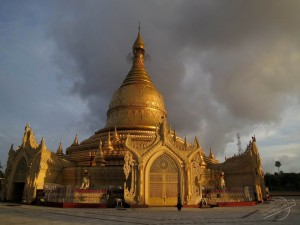Travel Day 1165 – Yangon to Bangkok, THAILAND
Sometimes it was really amazing to see how quickly time could pass by and in this case my allotted days in Myanmar simply felt not quite enough…
This was interesting because initially when landing in Yangon I had no real clue about what Myanmar had to offer and what was worth seeing. Obviously during the last 27 days I saw a lot of interesting sights and got to know the country a little bit, but I also learned about how much more there was to see. So while it was already clear that there would be another visit of Myanmar in the near future, on this very last day of mine I wanted to see at least the biggest symbol of Myanmar, the Shwedagon Paya…
But at first the day had to be started with a last bowl of steaming hot Mohinga, a vegetable noodle soup in fish broth. While most hotels and guesthouses served an uninspiring western style breakfast to foreigners, Mohinga was actually the unofficial national dish and was eaten throughout the entire country as a staple, hearty breakfast. For me Mohinga had become a big part of Myanmar as well as the sweet milk tea, British colonial architecture and golden payas, Buddhist stupas. All of these needed to be part of my last day…
Getting the food on the streets of Yangon was obviously no problem at all, seeing some more of the colonial buildings took a little walking effort, but visiting the famous Shwedagon Paya required some serious marching. Initially the Shwedagon Pagoda had been located outside the city on Singuttara Hill, next an artificial lake that had been built under British administration for fresh water supply of the newly founded capital. But by now the entire area of the hill and the lake had been grown into the extended city fabric of Myanmar’s largest city…
The first erection of Shwedagon Paya might actually go back some 2500 years when allegedly eight strains of hair from the Buddha found their way into Myanmar by the hands of two merchant brothers. Unfortunately this theory was really hard to prove today since this golden pagoda had been destroyed, rebuilt and overbuilt a few too many times since it came into existence. The only thing certain was that Shwedagon Paya was the most sacred Buddhist site in Myanmar…
While approaching this big golden pagoda on foot, its tall spire and crowning umbrella like hti could be seen already from far way. But once up close and at the bottom of the little hill, there appeared to be a multi-tired wooden entrance building framed by two huge stone lions. After that there was a covered, colonnaded walkway leading up to Shwedagon Paya along a seemingly endless collection of touristic souvenir shops. But the worst of it all was yet to come once I reached the massive golden foot of the pagoda…
The controversial government of Myanmar actually managed to place a money changer and an ATM right inside the holiest Buddhist structure of the entire country. Considering that ATMs were a novelty in Myanmar and all the guidebooks still talked about bringing enough crisp US dollar bills into the country to cover the entire trip, here they managed to place a modern cash machine right into the center of a religious structure. This commercialization of a spiritual place seemed especially disturbing because it seemed to turn against everything that the Buddha had once taught…
But the worst of it all was not only that the government had placed an ATM here and a money changer right beside it so that every foreign visitor could pay the steep entrance fee in US dollars, but they also decided to double the prices. This seemed so ridiculous to me and it really felt as if the government was not welcoming me as a visitor but rather treating me as an ATM as well, expecting some cash withdraw. So I did the only thing that seemed right in this situation, I waked in while refusing to pay…
The guards were obviously yelling and screaming at me, but they didn’t dare to touch me and so I entered, took some photos and then left this disgraced, US dollar tourist milking, pagoda. Luckily close by there was another smaller stupa, named Maha Wizaya Paya. This golden pagoda came without a price tag, without the crowds and without the souvenir nap. While the enjoying the calmness of the place, I had to think that Maha Wizaya Paya was representing the good old Myanmar and Shwedagon Money Paya was representing the future. But if the future of Myanmar looked like this, maybe the number of days on my visa was actually quite enough after all…
Find all Yangon photos here.




This making money habit eventually leads to a destruction of values….
Very true Gudrun, I was not very pleased with this ATM development…
Let’s ásk how much you need to pay to visit Vatican. “US dollar tourist milking” seems to be an overstatement